It’s been a few months since I’d reviewed a product, not because there isn’t anything new out there – but because I like things I can get excited about. Sure, I love fine, expensive optics, exotic telescopes and tech toys, but isn’t the whole point of asking for a product to use and abuse to give you an idea of what’s worth your hard-earned money and what isn’t? Yeah, I thought so, too. That’s why when I began researching Celestron products for “Guide To Space”, I knew I had to get my hands on one these to check out…
While the little kid in me still loves to get packages in the mail, the astronomer in me loves to open them up and see a brushed aluminum case inside the cardboard box even more. For those of us into the telescope game, we treasure cases of any kind and I have a wide collection of them – from discarded make-up kits to plastic power tool castoffs. I’ve found the object is to protect my equipment. While it doesn’t matter if one of my old sets of tripod legs fit great in an old tent pole bag, I’ve noticed it sure makes my heart beat a lot quicker if the case is shiny and has the manufacturer logo emblazoned on the front!
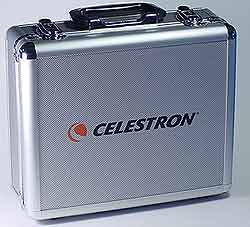 I wasn’t disappointed when I opened it either. The aluminum accessory case is well constructed with reinforced edges and corners, the hinges operate smoothly, the handle isn’t going to just come off and the latches are secure. Inside is lined with dense foam with circular cut outs for the included eyepieces with room for more and a rectangular cut out for the filters in their cases. First test? Ooops. I just dropped it from a height of about a meter and a half onto a hard surface and it didn’t pop open. Second test? I could set it on a hard surface and open it up and it didn’t flop over. Third test? Yeah. Everything inside was still where it was supposed to be! So far… So good.
I wasn’t disappointed when I opened it either. The aluminum accessory case is well constructed with reinforced edges and corners, the hinges operate smoothly, the handle isn’t going to just come off and the latches are secure. Inside is lined with dense foam with circular cut outs for the included eyepieces with room for more and a rectangular cut out for the filters in their cases. First test? Ooops. I just dropped it from a height of about a meter and a half onto a hard surface and it didn’t pop open. Second test? I could set it on a hard surface and open it up and it didn’t flop over. Third test? Yeah. Everything inside was still where it was supposed to be! So far… So good.
There’s a very good reason why I’ve referred to the Celestron 94303 Eyepiece and Filter Accessory Kit as a “telescope tackle box”. Like the many compartmentalized fishing buddy, this kit contains a wide variety of celestial “lures” that serve an even wider variety of purposes. Let’s take a look at each one and what I encountered over several days and times of viewing different objects:
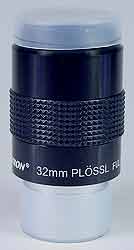 The least magnification factor of all the 1.25″ barrel eyepieces supplied here is the Celestron 32mm plossl. It’s an absolutely classic 4-element design and has a 44 degree apparent field of view, so how does it perform? With my 900mm focal length reflector is providing around 28X magnifying power. This gives outstanding view of wide field subjects such as the Orion nebula complex, the Plieades and combinations of objects such as M81 and M82… including great full disk lunar. The coatings perform very well and so do the optics. I don’t pick up any severe flaws at the edge of the field, the color correction is bright and clean (Orion nebula is grey/green as it should be, and the Plieades are blue) and the Moon doesn’t display reflections. In a 660mm focal length refractor, we’re only getting about 20X magnifying power and the 1525mm focal length reflector gives me about 48X. At all ranges, the Celestron 32mm plossl performs just fine and the eye relief is excellent.
The least magnification factor of all the 1.25″ barrel eyepieces supplied here is the Celestron 32mm plossl. It’s an absolutely classic 4-element design and has a 44 degree apparent field of view, so how does it perform? With my 900mm focal length reflector is providing around 28X magnifying power. This gives outstanding view of wide field subjects such as the Orion nebula complex, the Plieades and combinations of objects such as M81 and M82… including great full disk lunar. The coatings perform very well and so do the optics. I don’t pick up any severe flaws at the edge of the field, the color correction is bright and clean (Orion nebula is grey/green as it should be, and the Plieades are blue) and the Moon doesn’t display reflections. In a 660mm focal length refractor, we’re only getting about 20X magnifying power and the 1525mm focal length reflector gives me about 48X. At all ranges, the Celestron 32mm plossl performs just fine and the eye relief is excellent.
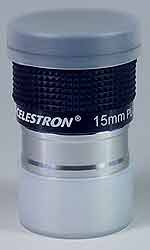 The next up is the Celestron 15mm plossl and a jump to about a 52 degree apparent field of view. First choice is the 900mm focal length reflector and a magnifcation factor of 60X. This is a little bit stronger than what I would have preferred for a mid-range magnification factor. For the 660mm focal length refractor, it provides 44X which is much better. This still keeps the Moon at a full disc and larger objects within range. However, in the 1525mm focal length reflector, it provides just over 100X – but at a great eye relief with bright, non-vignetted edges. This makes the 15mm plossl an exceptional large galaxy study eyepiece and makes small nebula nice and bright. Again, the color correction is outstanding and there are no spurious (optically caused) reflections around bright stars like Sirius.
The next up is the Celestron 15mm plossl and a jump to about a 52 degree apparent field of view. First choice is the 900mm focal length reflector and a magnifcation factor of 60X. This is a little bit stronger than what I would have preferred for a mid-range magnification factor. For the 660mm focal length refractor, it provides 44X which is much better. This still keeps the Moon at a full disc and larger objects within range. However, in the 1525mm focal length reflector, it provides just over 100X – but at a great eye relief with bright, non-vignetted edges. This makes the 15mm plossl an exceptional large galaxy study eyepiece and makes small nebula nice and bright. Again, the color correction is outstanding and there are no spurious (optically caused) reflections around bright stars like Sirius.
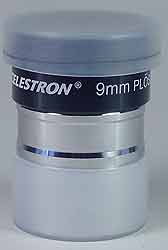 Now for the 9mm Celestron plossl. Into the 900mm focal length reflector it goes. Eye relief is marginal, but it does still carry the nice 52 degree apparent field of view at 100X. It’s showing me the same performance properties of the 17mm in a longer focal length telescope – but with less eye relief. In the 660mm reflector it provides 73X, which means you’re sacrificing some eye relief to get the magnification, but the images are still surprisingly bright and no coma at the edges. In the shorter focal length telescopes, this is a good galaxy study eyepiece and does surprisingly well a small bright nebulae, too. In the 1525 focal length reflector it gives around 170X which makes it just dandy for smacking resolution out of globular clusters and studying galaxy details while still keeping the object bright. This is also a great range for the longer focal length to use for lunar and planetary studies because you’re not hammering the magnification so much that the least atmospheric disturbance is so noticeable.
Now for the 9mm Celestron plossl. Into the 900mm focal length reflector it goes. Eye relief is marginal, but it does still carry the nice 52 degree apparent field of view at 100X. It’s showing me the same performance properties of the 17mm in a longer focal length telescope – but with less eye relief. In the 660mm reflector it provides 73X, which means you’re sacrificing some eye relief to get the magnification, but the images are still surprisingly bright and no coma at the edges. In the shorter focal length telescopes, this is a good galaxy study eyepiece and does surprisingly well a small bright nebulae, too. In the 1525 focal length reflector it gives around 170X which makes it just dandy for smacking resolution out of globular clusters and studying galaxy details while still keeping the object bright. This is also a great range for the longer focal length to use for lunar and planetary studies because you’re not hammering the magnification so much that the least atmospheric disturbance is so noticeable.
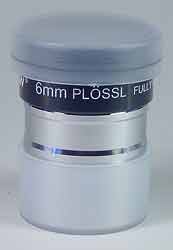 Ready for more? Then let’s go for the Celestron 6mm plossl in the 900mm focal length reflector. This gives 150X magnification factor and no where near the scope’s practical limits. Even though the apparent field of view is still good, the eye relief is beginning to really suffer. However, I am quite surprised to see the image remains fairly bright on galactic studies. In the 660mm focal length refractor I’m getting 110X, and while this scope isn’t a “light bucket” this magnification range make the scope rather exceptional on pretty double stars, lunar and planetary details. For example, Iota Orionis was easily split and very beautiful, it was possible to see glimpses of the Cassini division in Saturn’s rings and Comet Lulin filled the field! As far as performance is concerned, put the 6mm plossl in the 1525mm focal length reflector and you get 254X. Go on… Take a look at the Trapezium. You’ll see red and blue stars!
Ready for more? Then let’s go for the Celestron 6mm plossl in the 900mm focal length reflector. This gives 150X magnification factor and no where near the scope’s practical limits. Even though the apparent field of view is still good, the eye relief is beginning to really suffer. However, I am quite surprised to see the image remains fairly bright on galactic studies. In the 660mm focal length refractor I’m getting 110X, and while this scope isn’t a “light bucket” this magnification range make the scope rather exceptional on pretty double stars, lunar and planetary details. For example, Iota Orionis was easily split and very beautiful, it was possible to see glimpses of the Cassini division in Saturn’s rings and Comet Lulin filled the field! As far as performance is concerned, put the 6mm plossl in the 1525mm focal length reflector and you get 254X. Go on… Take a look at the Trapezium. You’ll see red and blue stars!
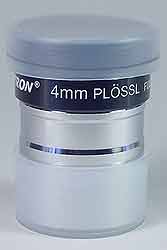 Last, but not least is the Celestron 4mm plossl. In the 900mm focal length reflector you get 225X. This is hammer time for lunar and planetary details – as well as double stars. The eye relief isn’t any worse than the 6mm, but you’re pushing the magnification to the point where the least atmospheric disturbance really begins to show. In the 1525mm reflector, this means 381X and just around half of what its practical magnification limits are. At this point, you are also dimming the image as well. In the 660mm focal length refractor it’s producing 165X and pushing it to its limits. While I’m getting nice airy disc, it just seems very “on the edge”.
Last, but not least is the Celestron 4mm plossl. In the 900mm focal length reflector you get 225X. This is hammer time for lunar and planetary details – as well as double stars. The eye relief isn’t any worse than the 6mm, but you’re pushing the magnification to the point where the least atmospheric disturbance really begins to show. In the 1525mm reflector, this means 381X and just around half of what its practical magnification limits are. At this point, you are also dimming the image as well. In the 660mm focal length refractor it’s producing 165X and pushing it to its limits. While I’m getting nice airy disc, it just seems very “on the edge”.
When it comes to the eyepieces included in the Celestron 94303 Eyepiece and Filter Accessory Kit, I found all of them to perform very well in every telescope I chose. You must remember the magnification factor of any eyepiece is the focal length of the telescope divided by the focal length of the eyepiece – and that every telescope has a practical magnification limit. You must also consider that while the same eyepiece performing at 100X in one telescope, will not perform like a similar 100X power in another telescope because each telescope is capable of different resolution factors and light gathering ability. With this in mind, know that each one of these eyepieces normally retail for around $45 a piece, are threaded for filters, have protective caps, produce a nice, flat field with no screaming vignetting, good color correction, excellent contrast and decent eye relief. In my book, that makes them a valuable asset to any eyepiece collection.
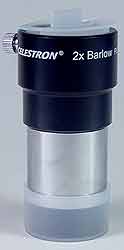 How about the barlow lens? Yes! There’s a 2X Celestron Barlow Lens here, too! For those of you who have never used a barlow, it’s a down and dirty, quick and convenient way of doubling the magnification power of any eyepiece – and preserving the eye relief. For example, and without being redundant, you can take any of the eyepieces reviewed above and simply double the magnification power when you place the barlow lens in the focuser before the eyepiece. In certain circumstances, this doesn’t seem to make a whole lot of sense to me because the wide variety of eyepieces included drop almost accordingly, but there is a marginal difference. Considering the barlow is an exceptionally useful tool to have in any astronomy kit and the fact that you might prefer the magnification factor and eye relief of say… the 15mm coupled with the barlow over the 8mm… it’s great that it’s in there! At around $40, the fully multicoated lenses certainly won’t cause any image degradation and the barlow just might be your cup of tea!
How about the barlow lens? Yes! There’s a 2X Celestron Barlow Lens here, too! For those of you who have never used a barlow, it’s a down and dirty, quick and convenient way of doubling the magnification power of any eyepiece – and preserving the eye relief. For example, and without being redundant, you can take any of the eyepieces reviewed above and simply double the magnification power when you place the barlow lens in the focuser before the eyepiece. In certain circumstances, this doesn’t seem to make a whole lot of sense to me because the wide variety of eyepieces included drop almost accordingly, but there is a marginal difference. Considering the barlow is an exceptionally useful tool to have in any astronomy kit and the fact that you might prefer the magnification factor and eye relief of say… the 15mm coupled with the barlow over the 8mm… it’s great that it’s in there! At around $40, the fully multicoated lenses certainly won’t cause any image degradation and the barlow just might be your cup of tea!
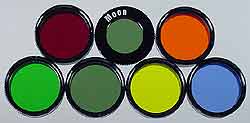 Now for the filters… 1.25″ glass telescope filters included with the Celestron Eyepiece and Filter Kit include Kodak Wratten #12, #21, #25, #56, #58A, and #80A. That’s awesome… But what do they do? First, let’s start with how they work. On the open end of the eyepiece barrel you’re going to find threads and these filters simply screw into these threads. What’s more, you’ll find the filter cells are also threaded to be connected to each other, so it is possible to “stack” filters. Using color filter with a telescope takes experimentation, and while you can recommend what each one is used for – only you can ultimately decide what works best for you! Each individual filter comes packaged in its own plastic padded case and they retail for around $15 a piece.
Now for the filters… 1.25″ glass telescope filters included with the Celestron Eyepiece and Filter Kit include Kodak Wratten #12, #21, #25, #56, #58A, and #80A. That’s awesome… But what do they do? First, let’s start with how they work. On the open end of the eyepiece barrel you’re going to find threads and these filters simply screw into these threads. What’s more, you’ll find the filter cells are also threaded to be connected to each other, so it is possible to “stack” filters. Using color filter with a telescope takes experimentation, and while you can recommend what each one is used for – only you can ultimately decide what works best for you! Each individual filter comes packaged in its own plastic padded case and they retail for around $15 a piece.
When it comes to #12 Yellow, you’ll find it reduces light transmission to 74%, thus helping to reduce glare around bright subjects such as the planets and Moon. It is known for enhancing orange and yellow features, and contrasting blue and green – such as those on Jupiter and Saturn – as well as giving nice contrast on lunar subjects. #21 Orange drops light transmission to 46% and blocks transmission of blue-green wavelengths. This means you’re going to enjoy this particular filter for seeing edge of maria detail on Mars (when Mars is close enough and big enough to enjoy) and it will improve some details in the equatorial belts on Jupiter and definitely make Saturn’s planet on the rings and rings on the planet shadow more defined. #25 Red only allows 14% of the light to come through, and this dandy little filter works well with large aperture scopes for seeing Mars polar caps and really rocks for digging unusual details off the lunar surface and helping to pick out Venus phases. #56 Light Green is a great all-purpose filter, allowing 53% transmission and works very well with Mars polar caps, Jupiter details and fine lunar details. It’s also a great “stacker” to enhance other filters, too. #58A Green gives 24% light transmission and it’s the world’s best set of telescope “sunglasses”. While it will help pick out odd ball features on Saturn, what you’ll find you use it for most is turning down the photons when observing the Moon and Venus! It also works very well in conjunction with a white light solar filter to help relieve eye strain while sketching. #80A Medium Blue is also another “classic” color filter. It provides 32% light transmission and although it will dim out other details, you’ll find it really helps when it comes to spotting the Red Spot and shadow transit events on Jupiter… and can even help distinguish differentiations in Saturn’s cloud patterns. This particular filter makes long-term lunar studies very eye friendly!
 Last, but not least? The neutral density filter. Like its predecessors, it retails for around $15, is threaded on both sides, made from high quality optical glass, fully coated and has about a 13% transmission factor. What makes it different is 0.9 density, which means it’s reducing glare while transmitting light in a uniform manner across the entire spectrum. While it appears to have a gray color – its color isn’t affecting the wavelengths of light. That makes the neutral density filter an exceptional tool to have in your kit, because it can be used to help “tone down” disparate double stars, take the edge off the Moon when watching an occultation, shave some of the light off Venus, enhance bright stars, and become a lunar, solar and planetary observer’s best friend. While it is often simply just called a “Moon Filter”, you’ll find that you’ll use this particular little disc more than any other over the years. So often, in fact, that you may often wonder why that galaxy looks so dim only to discover you’ve forgotten to take it out of your favorite eyepiece!
Last, but not least? The neutral density filter. Like its predecessors, it retails for around $15, is threaded on both sides, made from high quality optical glass, fully coated and has about a 13% transmission factor. What makes it different is 0.9 density, which means it’s reducing glare while transmitting light in a uniform manner across the entire spectrum. While it appears to have a gray color – its color isn’t affecting the wavelengths of light. That makes the neutral density filter an exceptional tool to have in your kit, because it can be used to help “tone down” disparate double stars, take the edge off the Moon when watching an occultation, shave some of the light off Venus, enhance bright stars, and become a lunar, solar and planetary observer’s best friend. While it is often simply just called a “Moon Filter”, you’ll find that you’ll use this particular little disc more than any other over the years. So often, in fact, that you may often wonder why that galaxy looks so dim only to discover you’ve forgotten to take it out of your favorite eyepiece!
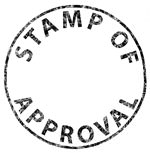 All in all, if you were to purchase each piece of the Celestron 94303 separately, you’d have about $365 in all of these cosmic lures. So, what does the Celestron Eyepiece and Filter Accessory Kit retail for? Try $139 plus shipping. Sure, you could go fishing for the stars with just the eyepieces included with your telescope and you’ll catch them… But sooner or later, you’re going to want to start adding other things to your telescope tackle box – and lasting value and practicality are going to be a point to consider. While these aren’t “prestige” products, they are well constructed, optically well above satisfactory for the price and one of the best daggone values I’ve seen in a long, long time…
All in all, if you were to purchase each piece of the Celestron 94303 separately, you’d have about $365 in all of these cosmic lures. So, what does the Celestron Eyepiece and Filter Accessory Kit retail for? Try $139 plus shipping. Sure, you could go fishing for the stars with just the eyepieces included with your telescope and you’ll catch them… But sooner or later, you’re going to want to start adding other things to your telescope tackle box – and lasting value and practicality are going to be a point to consider. While these aren’t “prestige” products, they are well constructed, optically well above satisfactory for the price and one of the best daggone values I’ve seen in a long, long time…
Way to go, Celestron…
My many thanks to Oceanside Photo and Telescope for once again providing us with a review product. It is very appreciated. I encourage all readers if you chose to purchase this kit from OPT, to be sure to place “Universe Today” in the club affiliation section when ordering to receive a discount on your final bill.

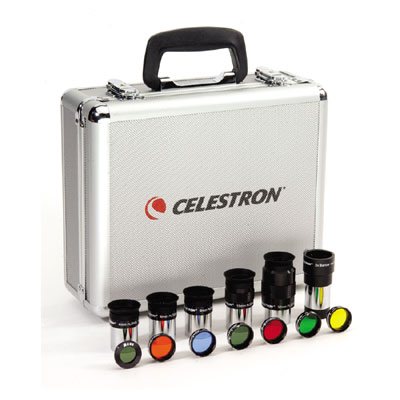
I already have a 14″ S-C scope and don’t really need anything else. For others who don’t have scopes, quality is the most important consideration, power means nothing in our fuzzy atmosphere. It is true the larger the scope, the better, however, unless you live in a truly light pollution free area, the weight of the scope can be a serious handicap trying to move it around let along bringing it to a dark site. I’ve been to ‘scope
parties’ around the southwest US, some of the scopes are amazing. I’ve seen modified Dobsonians 16-30″ diameter, relatively light frame, but when I do talk with the owners, they said it can be quite a deal to set up.
To protect my back and takes up much less space and don’t worry about collimating the
main mirror as moving a conventional reflector telescope will make main mirror get off balanced eventually and the image is terrible , and the easy of portability,I went to a relatively pricy 14″ Schmidt-Cassegrain with of cource the ‘puter controls and wireless to my 3 destop ‘puters.
. If you are going to buy a telescope for your child, don’t get a junky ‘scope from
Wal-mart, Fryes’ that advertise 1000 power,
and has a flimsy base or tripod as the child will be immediately turned-off by the terrible ‘jumpiness’ of any object. It may be better to just start your child off with a good binoculars or a better ‘scope for under $200 with a stable base . For the serious amateur
astronomer, we know the hobby is not cheap, however, compared with other hobbies, it may not really be that bad in price. (think sky-jumping as a hobby, quite expensive!!).
From about the age of 15-50 where wine, woman, family and song destroyed my mind and desire,lol, I finally got back to my childhood dream of having a scope and any clear dark night will use it and explore the amazing sights of our part of the Universe.
hi, robbi!
your advice is very sound, but i hope readers don’t take my use of magnifying powers here to be projected towards department store telescopes. don’t immediately assume when you see 225X that we don’t know what we’re talking about. (no offense – and i’ll explain why!)
for those of us who take our telescopy very seriously, it’s important to understand what magnification factor that each eyepiece provides with a certain focal length telescope. whenever you prepare a formal observing report, you must also include at what magnification factor the object was observed at. when considering buying an eyepiece collection, one must also consider if the collection fits inside all the practical limits of the telescope(s) it’s intended for – or else it isn’t a value.
the reason that department store telescopes don’t work isn’t because their optics are bad. on the contrary! you’d be surprised at how well some of these small refractors are made and can perform… the problem is the eyepieces and how the telescope was represented. you simply can’t push a telescope to its practical limits with a contrained eyepiece and expect performance! why on earth the included eyepieces with these type of telescopes offer way too much magnifying power remains a mystery to me… if you want proof? take one of these “cheap” telescopes, whack a .965 to 1.25 adapter in it and add a cheap 25mm eyepiece and then give it to a kid. suddenly they’re looking at the moon and stars at a “power” that’s right for that telescope, and although the mount could leave a bit more to be desired, it surely doesn’t stop them from wiping up some of us adults on the “who can find it first” game!
so, that was the point of including the magnifying powers at certain telescope focal lengths with each of these eyepieces. is pushing the practical limits of magnifcation on one or more telescopes worth buying a collection of eyepieces? what i found was the collection was more thoughtfully put together than i really imagined.
for my big aperture, high resolution, fast f/ratio telescopes – the 6mm and 4mm were pointless. they worked – but were uncomfortable because the scope isn’t driven. wow… guess what? that’s why the barlow was there. i could get the high magnifcation the scope is capable of and keep the eye relief. for the mid-range reflector, they all worked just fine – but the barlow was kinda’ pointless. for a small refractor, all the eyepieces and even the barlow was great, but many of the filters weren’t practical because it doesn’t gather enough light. by selecting these particular scopes, i also know what the performance limits are going to be with all the others that i have that fall in between – such as the long focal length SCT and the super fast 8″ EQ reflector.
would i trade my prized optics for ordinary plossls? no. but i would not learned what i know without them, either. it may shock you to know that 75% of my observations are done with totally common plossl eyepieces because i admire their flat field and i consider them my “work horses”. there is a celestron plossl eyepiece left in my solar scope and lunar scope at all times because i know if i’m going to take a few minutes of my time to observe at a moment’s notice that i want my equipment right there and ready. if i boof up a $40 eyepiece by whacking it with my digital camera lens when photographing a sunspot – i’m gonna’ be far less upset than if i do it to a $200 eyepiece. (and chances are, i won’t even try the photography if the expensive eyepiece is in there. see what i mean about wanting to use the “work horse” because you’re not afraid of it?)
in the long run, the decision is always up to you! for those who are interested in buying a small collection of filters, you’re getting the most popular ones here with bascially eyepieces, barlow and case thrown in for free. for those looking for a variety of “work” eyepieces? hey… you’re getting a case, filters and barlow for free. for those that already have a multitude of eyepieces, filters and barlows? hey… you already know what i’m talking about and you know this assembly is a dandy little travel companion for those of us who pack around a variety of telescopes to do public outreach or need to equip an astronomy club or observatory with additional tools.
robbi? thanks for your good advice about department store telescopes – and don’t let going past 50 stop you from wine, women and song, eh? i’ve noticed when the clouds roll in around these parts that a few of us aren’t above destroying a few brain cells for the love of science…
or a good time!
I picked this set up recently, it also gets my stamp of approval.
Hi Tammy, when I say to someone who is thinking about buying a scope for their child, do not use ‘power’ of a telescope as one of the reasons to purchase a telescope , it will be worthless power! There is a useful criteria-up to about a 3″ reflector-refractor scope, the useful power is about 50x 1 inch of scope, for 3 inch telescope that will be about 150x.-any use over that power is worthless as the light gathering power makes the object worthless to observe.
From about 4″ to 6″ scope, it would be more
like 30x to 40x per inch.- or about 160x-240x
for the 6″ telescope.
For the first ‘scope -having or purchasing a decent 12.5mm and 25mm eyepiece is a great help, many will think about a 6mm or 4mm-I say eventully, the 12.5mm will be the eyepiece most used, regardless of the size of the scope. Tammy, as you said, the 6mm and 4mm may be used once or twice and about it.!!
I’ve talked with other persons who has at least a 6″ retractor (what a tube length and pricy) and very large reflectors, most of us find much more than 20-30x per inch quite worthless because of our atmosphere.
Although I have a 14″ S-C scope, I rarely use over about 250-300 power as there is the problem of atmospheric ‘waves’ . Anytime I use over 300x is to observe a difficult double star-other type objects are considered worthless to observe due to the atmosphere!
All my eyepieces are Plossi and they are
great!! Tammi, I don’t know what’s wrong with them but I love them. I use the 15mm
the most and the 32mm on the most clearest but most unstable atmosphere nights.
Tammy, thank you for your feed and column advice, and I hope people read why a stable, decent first scope and the true useable power I’ve added for a first scope is very important if you buy a ‘scope for a child.
For those who has advanced ‘scopes, Tammys’ feed and column is a great reminder what is out there and available as some people forgets there are great filters available that can help much in a light polluted metro areas and many other specialized filters always being more improved.
addendum-Tammi, Sacramento, California and the state in general is getting some of the rains we need, but we need much more rains and snows for the mountains. I’ve a feeling the mothballed desalination facility at
Santa Barbara, California will have to go online and other desalination plants will eventually have to be constructed as California nears 40Million people and we don’t have enough rain and snow for the mountains in this very undependable mediterranean climate California has,I’ll gladly have rainy skys instead of clear skys
for the rest of the ‘rainy’ season which usually ends about middle of April.
I’m still destroying alot of brain cells for the love of science .Lol.
Take care
Tammy-this concerns my childhood telescope-my family bought a Tasco 60mm refractor telescope in 1959 for $29, it was set on a heavy medal tubular type adjustable pedestal stand with 5 point base-it was not known to me or my family at the time how stable the base is! I used it on as many of the the rare clear nights when growing up in San Francisco-of course I left home to go into the service then got married and have kids. That telescope is now at my brothers’ large 5200 sq ft home in Pacifica, California on a hill with a awesome view of the lower terrain and the wide Pacific Ocean and the telescope is in the ‘Sunroom’ always set to see the view of ships at sea or the Pacifica Pier about 2 miles away-I’ve purchased better 12.5mm and 25mm 1.25″ eyepieces when I was a kid. After 50 years, that telescope is still in excellent condition. The company went out of business a few years back, but when I checked to see what the price for the excellent optics for that 60mm was about 7 years ago, it was shocking to see the price was over $300-my family said they could have bought a flimsy telescope for $25 but my parents was into the ‘heavier the better’.
It was a very fortunate discision.
The quality of the eyepieces has increased incredibly. When I got my telescope, it had a Ransdom (forgot the true name lol) a very cheap 2 piece eyepiece so I got the much better Kellner. The best eyepieces in the early 60s’ was the orthoscopic (forget spelling) and the Erfel-these best eyepieces was extemely pricey. Today, the Plossl or super Plossi is far more advanced and far better than the best eyepieces on the early 60s, and the value for the money is far better!
The orthoscopics and Erfels were about 40-$ 75 in 1960,today, the Plossi/super plossi is about the same price. When I retired about 2.5 years ago, before I and some of our relatives went to Europe and other places,I spent about 6 hours to take apart the 60mm
main housing of the childhood telescope, and carefully took apart the 2 60mm glass and separator and gave it it’s first true cleaning then put it back together. I also took apart the 12.5mm, 25mm and 6mm eyepieces, with small tools and cleaning equipment gave them their first true cleaning. Although the telescope had the plastic cover to protect the main 60mm glass and eyepieces with covers to prevent dust, still, near 50 years of pollution from when we used to smoke and other pollution in the air, the results were amazing!!. I don’t advise anyone to clean a newtonian reflector mirror, just use an dry air-blower used to take off the dust of ‘computer parts. As anyone who knows telescopes reading this feed, the surface coating on a newtonian/dobsonian
mirror is SURFACE coated and is very sensitive and thin. Needless to say, prevent
dew from ever forming on the mirror.If you must insist on cleaning your mirror, check the ‘net for advise, and prepare for an all-day
chore as removing the mirror from the mounts is critical and the rest is of utmost importance!
Tammi already mentioned it, but good eyepieces can makes an average scope quite a bit better or much better. I was thinking of getting a 12.5mm Plossl for my now brothers scope, but they said don’t bother(I use 2” diameter eyepieces so none will fit the 1.25″ eyepiece slot of the 60mm ‘scope
Tammi-on my Feb10 4:25pm post, I should
have said when I directly look into the eyepiece, the eyepiece I use the most is 56mm and perhaps the 32mm, I have to remember when I post here what I really use as a wireless remote viewing on my ‘scope from my ‘puters versus when directly looking thru the scope. Another wireless eyepiece I use is the Plossl 25mm Illuminated Reticle CCD Framing Ocular , however, on warmer nights, nothing beats looking directly thru the eyepiece as .M41 and many others continues to look far better than CCD, but I’m still on a learning curve with CCD
I don’t know if any other of your older readers suffer from ‘floaters’? When I use a high magnification on any telescope, the field is shrouded behind a tracery of sharply focussed floaters, ruining the view for me.
I suppose it must be the small diameter of the exit pupil that brings these floaters into sharp relief.
Anyway, although I haven’t looked very hard, this is a problem that I’m sure must afflict a fair number of ageing amateur astronomers and yet coverage in the literature seems to be non-existent. It certainly rules out high magnification study of the Moon or planets for me.
DrBill- for a few years,I started to get the floaters on my left eye while the glasses I used to correct my myropia or near sightedness no longer worked as I still had left eye blurriness.. I had cataracts forming, about a year ago, I had the cataracts taken out by lazer surgery, the floaters did not re-appear. Floaters are common on aging eyes, examining the eyes every year or 2 by an optometrist or physician qualified to check the eyes for the dreaded macular retinal degeneration is very important, there are ways to slow down greatly the macular degeneration and research is always improving the span of sight.
Dave, if you think you vision is different for each eye, check for possible cataracts-note, should the doctor find them, he will also check if you have high blood pressure or high colesterol- to keep the risk of lazer surgery and complications at a minimum, the doctor will say to have your main doctor give medication to lower the blood pressure and colesterol, I was lucky I did not have both.
to take out the cataracts took about an hour and wore a patch over the left eye for a few days. Laser surgery is something, a real miracle than a generation or so ago, either you eventually saw a world liken to seeing underwater for the rest of your life, or probably risk a doctor who had too much to drink the night before and still has booze breath and shakey hands while holding the sharp eye slitter. lol.
Just something to think about if you believe you have cataracts, common on aging people, floaters are common,severe floaters usually means you most likely have cataracts.
Generally, by 50yo ,most peoples pupil size will be useful at 5mm, younger it was 7mm,
I can’t properly discribe here, but if you thru a a 7x50mm binoculars versus a 10x50mm binoculars, the 10x50mm will be easier to see thru, while at a younger age, the 7x50mm is really the best, brightest view of an object and younger people can utilize the wide imaging size of the eyepiece results to the potential. An aging eye can;t see the true full size of the image thru a 7x50mm binocular.
gosh… i’m sorry i took so long to check back on this thread!
for both of you (and for anyone else reading), cataracts are a reality. i just had cataract surgery done on both eyes because i had gotten to the point where i was almost blind. i could no longer drive – nor practice astronomy. (and that’s why you hadn’t seen a scope review in awhile, too.) while using optics eased things out – my left eye was total toast and i have a lot of unanswered questions – mainly about using first generation solar filters for so many years and knowing my left eye was my predominate study eye. i’m not trying to lay blame for what happened to my eyes somewhere – just trying to understand why it would appear that amateur astronomers tend to get “early” cataracts more often than say… skydivers. (and chances are it is simply because we are more optically aware.)
before i get away from the cataract issue, don’t fear the surgery and go right the heck around your regular optometrist if you even suspect you might have them. take it from someone who was coerced into several pairs of unneccessary new glasses and bifocals, etc. when the problem wasn’t my prescription – but my eyes. by the time i got tired of the regular eye doc telling me that what i was telling her couldn’t be (that i was seeing 6 moons instead of one) and went to the specialist, he told me it was a wonder that i could see at all because the lens in my eye was so degraded. although i miss the pretty rainbows… i sure don’t miss wearing glasses anymore!
anyhow… it’s painless, quick and you’ll get new eyes. 😀
now that everything is fixed? i’m back to being able to use high magnification again and today’s ED glass eyepieces are by far the best with their long eye relief. however, in a driven scope, i don’t have a problem with short eye relief. funny though… in my scopes that have a tremendous amount of resolving power (less than 0.5 arc seconds) i find i can enjoy absolute minimums of magnification and still see details just as clearly. but… that’s the scope and not the eyepiece.
don’t give up those old refractors and eyepieces! even though they aren’t as performance as today’s standards, they are absolute classics. does anybody out there remember the first edmunds scientific refractors and dynascope? these old babies rocked… and so did some of the first tasco!
Hi Tammi and all, just got back from Reno Nevada with relatives, we go for food and shows as we really don’t gamble,many some nickels lol. I’ve occasionally touch base with former co-workers as I have retired 2 years ago age 55 so I can keep pace with Network security and sofeware issues as I retired as Network Administrator,software and hardware. I also checked users PC problems, I talked with some why some are only in their 40s’ and some already had cataracts, they did not use telescopes, so I can’t blame amateur astronomers for having premature cataracts. The pupils of an older eyes does decrease, effectively from 7mm for a younger to 5mm for an older person, thus the eye relief of a binocular can be a test. I don’t have problems using higher power as the ”scope I use don’t require a 4mm or 6mm eyepiece-I use those eyepieces remotely from inside wireless on my ‘puter driven scope so I can view on my ‘puter in the warmth of indoors lol… I was fortunate my optomistrist did not try to make money by having me get new glasses, he referred me to an optomologist and eventually got my cataracts deleted. I still wear glasses due to myropia or near-sightedness and sometimes use the other glasses for problems seeing things close by so I use them for reading or looking at the desktops or ‘lappy PCs’. I hope you read about my childhood telescope on previous posts on this feed and what the Tasco and now doing and Edmund Scientific was my favorite hobby mail order store with their catalogs-I still have a 1959 catalog!! I still have an elbow scope WW2 vintage and other lens and things
California is raining and we need a few more storm of this type to help fill our reservoirs.
Pardon my spelling,I don’t use wordspell but you get the idea lol
Take care
i dont usually comment, but after reading through so much info i had to say thanks